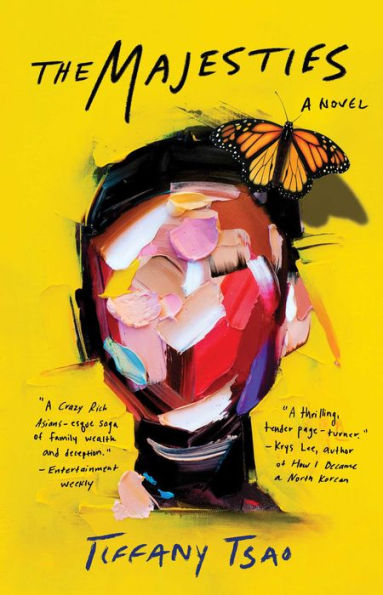
Written by Stephen Hong Sohn
Edited by Uttara Rangarajan
I seem to have slightly overdone the creative nonfiction thing because I ended up reading four fictional works in a row, and I’m in the middle of a fifth. The first I am reviewing is actually a re-read of a novel: Tiffany Tsao’s The Majesties (Atria, 2020). I read this not long after the book came out, but I realize that I never actually reviewed it, so here I am. I can’t believe how much I forgot, especially the last chapter with the major, Shyamalanesque reveal (no, she doesn’t see dead people, but there’s something like that, and I will spoil it all). Let’s let the marketing description propel us further: “Gwendolyn and Estella have always been as close as sisters can be. Growing up in a wealthy, eminent, and sometimes deceitful family, they’ve relied on each other for support and confidence. But now Gwendolyn is lying in a coma, the sole survivor of Estella’s poisoning of their whole clan. As Gwendolyn struggles to regain consciousness, she desperately retraces her memories, trying to uncover the moment that led to this shocking act. Was it their aunt’s mysterious death at sea? Estella’s unhappy marriage to a dangerously brutish man? Or were the shifting loyalties and unspoken resentments at the heart of their opulent world too much to bear? Can Gwendolyn, at last, confront the carefully buried mysteries in their family’s past and the truth about who she and her sister really are?”
This description does not provide much information about the ethnic and transnational elements of this text. Most of the story concerns the rich Sulinado family who are Chinese Indonesians. Estella and Gwendolyn seem to be close sisters, though Estella ends up marrying a man that distances her from the family at large. The marriage is still supported by the Sulinados because Estella’s husband is none other than the son of another rich family, but that family’s wealth craters. For her part, Gwendolyn ends up managing one side of the family business, which involves animated jewelry. If that phrase doesn’t make sense to you, that’s okay. Animated jewelry is exactly what it sounds like. Imagine that the necklace you’re wearing can briefly take flight and then return around your neck. That’s exactly what Gwendolyn’s business designs. To make these unique creations, Gwendolyn actually has to cultivate a kind of fungus that is known to make insects turn into zombies, as their mobile functions and actions are taken over. The whole point is that the fungus can be used to move things and thus make jewelry in new ways. Not surprisingly, the venture is a success and Gwendolyn’s business thrives. Estella is way more ambivalent about her family’s affluence and searches for an aunt who may or may not be alive. Taking Gwendolyn with her, Estella finds out where this aunt is hiding, and they discover the very complicated and tragic story that led her to break complete ties with the Sulinados. Suffice is to say that wealth brings a lot of privilege, including the possibility that the family can orchestrate the apocalyptic ending of any relationship that it does not approve of (in this respect, it does remind me of something from C. Pam Zhang’s Land of Milk and Honey). Now, to that ending (and another spoiler warning)! So, the novel is written en medias res and sort of anachronically. The last chapter gets us to the point essentially of where we started the novel, with the entire Sulinado family, sans Gwendolyn and Estella, dying What we discover is that Gwendolyn and Estella are actually*drum roll please*the same person! Yes, so we have one of those split identity stories that I’ve seen a number of times (see An Na’s The Place Between Breaths and Emiko Jean’s We’ll Never Be Apart for variations on this plot). I wasn’t entirely sold on it, but hey that’s just me! Unfortunately, when I looked up some of the links to this book, a lot of the reviews mentioned Crazy Rich Asians. This novel is definitely not that one, and I think anyone who comes into it thinking that it would be the same has not read any of the actual marketing materials. Tsao has written transnational, Asian American class satire, one that drives home the ethical quandaries that derive out of affluence.
Buy the Book Here